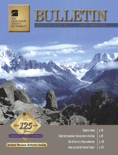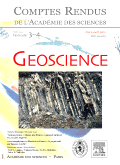
GEOSCIENCES JOURNAL
Scope & Guideline
Pioneering Insights into Earth's Complex Systems.
Introduction
Aims and Scopes
- Tectonics and Earth Processes:
Investigates the dynamics of Earth's crust, including fault mechanics, seismic activity, and tectonic evolution, with a focus on regions such as Korea and the broader Eurasian plate. - Geochemistry and Mineralogy:
Explores the chemical composition and mineralogical characteristics of geological materials, emphasizing petrogenesis, mineral exploration, and environmental geochemistry. - Volcanology and Seismology:
Studies volcanic activity and seismic events, including the physical processes behind eruptions and earthquakes, and their effects on surrounding environments. - Hydrogeology and Aquifer Studies:
Focuses on groundwater systems, including karst aquifers, groundwater quality, and the impact of human activities on hydrological processes. - Remote Sensing and Geophysical Techniques:
Utilizes advanced geophysical methods and remote sensing technologies for subsurface imaging, environmental monitoring, and geological hazard assessment. - Paleoenvironmental and Quaternary Studies:
Examines past environments and climate changes through sediments and fossil records, providing insights into historical geologic processes.
Trending and Emerging
- Climate Change and Environmental Impact Studies:
Research focusing on the impacts of climate change, such as hydrological changes and wildfire effects on ecosystems, has gained traction, highlighting the urgency of addressing environmental issues. - Geophysical and Remote Sensing Innovations:
There is an increasing trend in the application of innovative geophysical techniques and remote sensing for subsurface exploration and monitoring, indicating a shift towards technology-driven research. - Natural Hazards and Risk Assessment:
Studies on natural hazards, including earthquake prediction and volcanic risk assessment, have become more prominent, reflecting a growing societal concern for disaster preparedness and resilience. - Integrated Approaches in Geosciences:
The trend towards interdisciplinary research, integrating geochemistry, geology, and geophysics, is emerging as a significant focus, promoting a more holistic understanding of Earth systems.
Declining or Waning
- Geological History and Stratigraphy:
There has been a notable decrease in studies specifically focused on stratigraphic classifications and geological history, possibly overshadowed by more applied research themes. - Traditional Geology Methods:
The reliance on classical geological methodologies, such as basic field mapping or standard mineral identification techniques, appears to be waning in favor of more advanced and integrated approaches. - Mineral Resource Exploration:
Research related to conventional mineral resource exploration has diminished, reflecting a potential shift towards sustainability and environmental impact assessments.
Similar Journals

GEOTECTONICS
Pioneering Insights into Earth's Geological Processes.GEOTECTONICS is a distinguished academic journal published by PLEIADES PUBLISHING INC, focusing on key developments in the field of geology. Established in 1978, the journal has dedicated itself to exploring the intricate processes and phenomena associated with Earth's tectonic systems, making substantial contributions to Earth and Planetary Sciences. With an impressive impact factor reflected in its Q2 ranking within the Scopus category of Geology, GEOTECTONICS stands out as a valuable resource for researchers, professionals, and students alike. The journal offers a platform for rigorous peer-reviewed research that spans both fundamental theories and practical applications in geosciences, affirming its significance in fostering academic discourse and advancing geological knowledge. Although it currently does not offer open access, the journal's accessible format and continued publication through to 2024 ensures that it remains at the forefront of geoscientific inquiry.

Geodynamics
Connecting Research and Real-World Geophysical ChallengesGeodynamics is an emerging scholarly journal published by LVIV POLYTECHNIC NATIONAL UNIVERSITY, dedicated to advancing knowledge in the fields of Earth and Planetary Sciences, with a particular emphasis on Geophysics, Geology, and related specialties. Featuring both ISSN 1992-142X and E-ISSN 2519-2663, this journal aims to publish high-quality research that addresses critical challenges in geodynamic processes and their implications on our planet's systems. Despite its nascent status, having converged years from 2023 to 2024, Geodynamics is poised to attract attention in the academic community, especially as evidenced by its rankings in Scopus, which position it prominently within the discipline. The journal's commitment to open access ensures that cutting-edge research is readily available to the global scientific community, fostering collaboration and innovation. Researchers, professionals, and students will find Geodynamics an essential resource for the latest findings and discussions in geodynamics and related fields, making it an invaluable addition to the landscape of environmental science journals.

Solid Earth
Exploring the Depths of Geological KnowledgeSolid Earth is a prestigious open-access journal published by COPERNICUS GESELLSCHAFT MBH, dedicated to advancing the understanding of geological and environmental sciences. With an ISSN of 1869-9510 and E-ISSN 1869-9529, this journal has been at the forefront of the Earth sciences since it became fully open access in 2010. Based in Göttingen, Germany, it features a rich array of interdisciplinary research relevant to earth-surface processes, geochemistry, paleontology, and geophysics, among other fields. The significance of Solid Earth is underscored by its rankings in the Q1 category across multiple related disciplines, demonstrating a strong impact factor within the community. As of 2023, it stands out with an impressive Scopus ranking, pushing the boundaries of knowledge and research excellence. By providing a platform for high-quality scientific contributions, Solid Earth is essential for researchers, professionals, and students looking to explore and disseminate impactful findings in the pursuit of sustainable earth science advancements.

Journal of Earth Science
Connecting global minds through open access geoscience.Journal of Earth Science, published by the China University of Geosciences, Wuhan, is a leading journal in the field of Earth and Planetary Sciences, recognized for its significant contributions to the understanding of geological processes and environmental challenges. With an impressive Q1 ranking among Earth and Planetary Sciences journals and a strong position at Rank #39/195 in Scopus, this journal not only showcases high-quality research but also serves as a crucial platform for disseminating innovative findings, spanning a broad spectrum of topics from geophysics to climate change. The journal adopts an open access model, which enhances the visibility and accessibility of research articles published from 2009 to 2024, thereby facilitating collaboration and knowledge sharing among the global scientific community. With its commitment to advancing geosciences, Journal of Earth Science is invaluable for researchers, professionals, and students alike, eager to stay informed and contribute to ongoing discussions in this dynamic field.

Journal of Asian Earth Sciences-X
Exploring the Depths of Asian GeosciencesJournal of Asian Earth Sciences-X, a distinguished publication by ELSEVIER, is at the forefront of Earth and planetary sciences, particularly focusing on the dynamic fields of geology and earth-surface processes. As an Open Access journal since 2019, it provides unparalleled access to high-quality research, fostering global collaboration and dissemination of knowledge. With an impressive impact factor and ranking in the Q2 category for both Earth-Surface Processes and Geology, it serves as a crucial platform for researchers, professionals, and students alike to share their findings and insights. Situated in the United Kingdom, the journal thrives on contributions that enhance our understanding of Asian geosciences within a broader global context, aiming to tackle major challenges such as climate change and natural resource management. By bridging regional studies with global perspectives, the Journal of Asian Earth Sciences-X is not only a vital resource for academia but also supports sustainable development initiatives across the region.

Moscow University Geology Bulletin
Unveiling Planetary Insights Through Innovative StudiesMoscow University Geology Bulletin, published by SPRINGER INT PUBL AG, is a prominent platform for disseminating critical research in the field of Earth and Planetary Sciences. With an ISSN of 0145-8752 and an E-ISSN of 1934-8436, this journal is well-regarded for its contributions to diverse geological studies and interdisciplinary advancements that shape our understanding of the planet. The journal has established itself in the academic community, particularly noted for its ranking in the Q3 category within Earth and Planetary Sciences as of 2023. Despite its limited open-access options, the Moscow University Geology Bulletin remains an essential resource for researchers, professionals, and students through its well-curated articles and synthesis of geoscientific knowledge. With annual volumes converging from various years, including significant years like 2012 to 2024, it aims to uphold its mission of fostering scholarly dialogue and innovation in the geosciences.

GEOLOGICAL SOCIETY OF AMERICA BULLETIN
Pioneering Insights in Geological Research Since 1890The Geological Society of America Bulletin (GSA Bulletin), with ISSN 0016-7606 and E-ISSN 1943-2674, is a premier scholarly journal published by Geological Society of America, Inc. Based in the United States, this journal has been a cornerstone of geological research since its inception in 1890, making significant contributions to the understanding of Earth sciences over more than a century. Recognized for its rigorous peer-review process, the GSA Bulletin currently holds a prestigious Q1 ranking in Geology, positioning it among the top 14 journals in Earth and Planetary Sciences in terms of Scopus ranking, reflecting the high quality and impact of the research it publishes. Researchers, professionals, and students alike benefit from its comprehensive coverage of geological topics, including sedimentology, volcanology, and paleontology, which supports the advancement of knowledge in the geosciences. While the journal is not open access, it continues to provide a vital platform for innovative research and critical discussions that shape the future of geology.

Journal of the Geological Society of Korea
Catalyzing Collaboration in Geological ResearchJournal of the Geological Society of Korea, published by the Geological Society of Korea, is a pivotal platform for researchers and professionals in the field of geology and earth sciences. With an ISSN of 0435-4036 and an E-ISSN of 2288-7377, this journal fosters the dissemination of scholarly articles that encompass a wide range of topics within earth and planetary sciences. Despite being categorized as Q3 in both Earth and Planetary Sciences (miscellaneous) and Geology, the journal has made significant strides in contributing to academic discourse, with a Scopus rank indicating robust participation in its academic field. Located in Seoul, South Korea, the journal aims to provide a comprehensive resource for the geological community, inviting submissions from both Korean and international researchers alike. With the convergence of years from 2019 to 2024, the Journal of the Geological Society of Korea stands as a vital resource for advancing our understanding of geological phenomena and fostering collaboration within the global geosciences community.

DOKLADY EARTH SCIENCES
Bridging Gaps in Earth Science UnderstandingDOKLADY EARTH SCIENCES is a reputable journal published by MAIK NAUKA/INTERPERIODICA/SPRINGER, focusing on the dynamic field of Earth and Planetary Sciences. With an ISSN of 1028-334X and E-ISSN 1531-8354, this journal offers a platform for researchers to disseminate their findings and insights that contribute to our understanding of Earth systems over a continuous publishing span from 1998 to 2024. It currently holds a Q3 quartile ranking in the Earth and Planetary Sciences category, reflecting an emerging yet significant impact within its field, evidenced by its Scopus ranks where it stands at 123rd in general Earth sciences and 113th in miscellaneous Earth sciences. DOKLADY EARTH SCIENCES aims to bridge research gaps and foster collaboration among a diverse audience including researchers, professionals, and students committed to advancing knowledge in geoscience. The journal stands as a vital resource for those seeking to explore contemporary challenges and innovations within the realm of Earth sciences.

COMPTES RENDUS GEOSCIENCE
Empowering Research for a Sustainable Planet.COMPTES RENDUS GEOSCIENCE, an esteemed open-access journal published by ACAD SCIENCES since 2020, serves as a vital platform for disseminating significant research in the field of Earth and Planetary Sciences. With an ISSN of 1631-0713 and E-ISSN of 1778-7025, this French journal is located at 23 Quai de Conti, Paris, 75006, France. Focusing on various sub-disciplines, it is recognized in the 2023 category quartiles as Q2 in Earth and Planetary Sciences (miscellaneous) and Q3 in Global and Planetary Change. The journal ranks #82 out of 195 in Earth and Planetary Sciences and #79 out of 120 in Environmental Science, reflecting its commitment to quality scholarship and impactful research. The journal's open-access model enhances accessibility, ensuring that researchers, professionals, and students alike can freely engage with cutting-edge findings that contribute to a deeper understanding of our planet and its systems. The ongoing convergence of knowledge from 2002 to 2024 positions COMPTES RENDUS GEOSCIENCE as a crucial resource in the evolving landscape of geosciences.